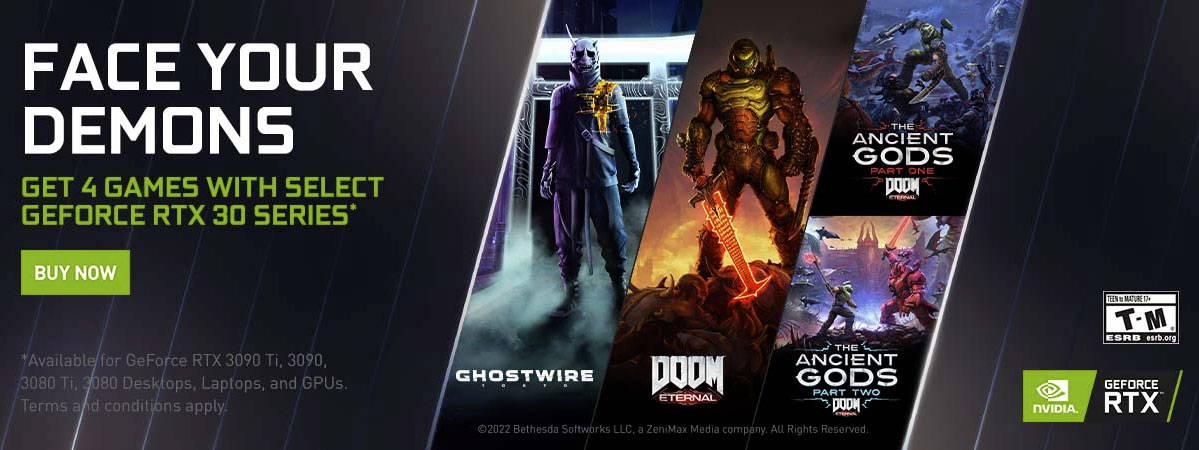Nvidia Pushes Premium GeForce RTX 30 Sales With Face Your Demons Bundle
Bundling of four demonic games, for RTX 3080 or better
Nvidia and its partners have launched a new GeForce gaming bundle for anyone looking at buying one of the best graphics cards. The Face Your Demons bundle is only for buyers of high-end systems (desktops and laptops) with GeForce RTX 3080 or better GPUs, or for these GPUs sold individually. Starting today and running until September, qualifying buyers can get the following four titles with their purchase: Ghostwire: Tokyo, DOOM Eternal, and DOOM Eternal: The Ancient Gods Parts One and Two.
Nvidia published a US promo page with the various terms and conditions. Multiple partners have also hit social media to promote the bundle. A cursory glance at Twitter shows hardware partners like Asus ROG, Acer, and Zotac promoting the bundle, which kicks off today. Meanwhile, retail partners worldwide were also seen promoting Face Your Demons, including Micro Center, Komplett, Scan Computers, and more.
Unfortunately, this bundle is for high-end buyers only. That means purchasing a graphics card or system featuring the RTX 3080 and above. For example, Asus sells both laptops and graphics cards that qualify for the bundle, Acer has both desktops and laptops, while Zotac only sells dedicated graphics cards. To be clear, the qualifying GPUs that must be part of your purchase are the GeForce RTX 3080, 3080 Ti, 3090, and 3090 Ti.
It's interesting to see this high-end-only GPU promotion from Nvidia and partners, as it hints it's currently hardest to shift these SKUs. The recent price action and pricing trends over recent months also suggest that Nvidia and its partners have had to cut the higher-end SKUs the deepest to gain sales traction. For example, the Gigabyte GeForce RTX 3080 Gaming OC 12G is currently being sold at an all-time-low of $729 at Newegg, where it previously sold for $1,349.
If we continue with the above logic, it would indicate that RTX 3070 Ti and below GPUs don’t need any bundling help (yet?) to shift units from the shelves. Perhaps the stock situation is better for the retailers too, meaning there isn’t as much inventory to worry about holding.
Last month AMD began redemptions for its Raise the Game bundle promotion. AMD’s bundle was much more generous to higher-end GPU buyers, but at least entry- and mid-market buyers got some treats, unlike with Nvidia’s bundle today.
For anyone tempted by either the Nvidia or AMD graphics card and games bundles, our roundup of the Best Amazon Prime Day Graphics Card Deals is a great place to start. It's also great to see bundles back for both green and red team GPUs, and we hope it continues with the introduction of the highly anticipated GeForce Ada Lovelace RTX40 series graphics cards, and Radeon RDNA 3 RX 7000 series graphics cards, due later this year.
Get Tom's Hardware's best news and in-depth reviews, straight to your inbox.

Mark Tyson is a news editor at Tom's Hardware. He enjoys covering the full breadth of PC tech; from business and semiconductor design to products approaching the edge of reason.
-
cryoburner ReplyUnfortunately, this bundle is for high-end buyers only. That means purchasing a graphics card or system featuring the RTX 3080 and above.
The cards that really need bundles or rebates are the more mid-range to lower-end models. Many 3080s and above are actually relatively close to their intended MSRPs now, while anything lower seems to still be marked up by around 25-30%, as retailers don't want a take a loss on cards they bought at high prices before the crypto market collapsed.
It's interesting to see this high-end-only GPU promotion from Nvidia and partners, as it hints it's currently hardest to shift these SKUs.
It could also be more that they know these cards will be the soonest to be replaced by new models. Nvidia tends to release higher-end models first, so it's possible that we will see 40-series cards in the $700+ range on the market within a few months or so, while cards in the sub-$500 range will likely take longer, with most probably not launching before the end of the year. So, they're rushing to get existing high-end units sold before the new ones get announced and they become a lot harder to sell near those prices, but there's less rush to move the mid-range models, at least for now. So it's not necessarily that the retailers have less stock of those cards, just that they know they have some additional months to sell them.

